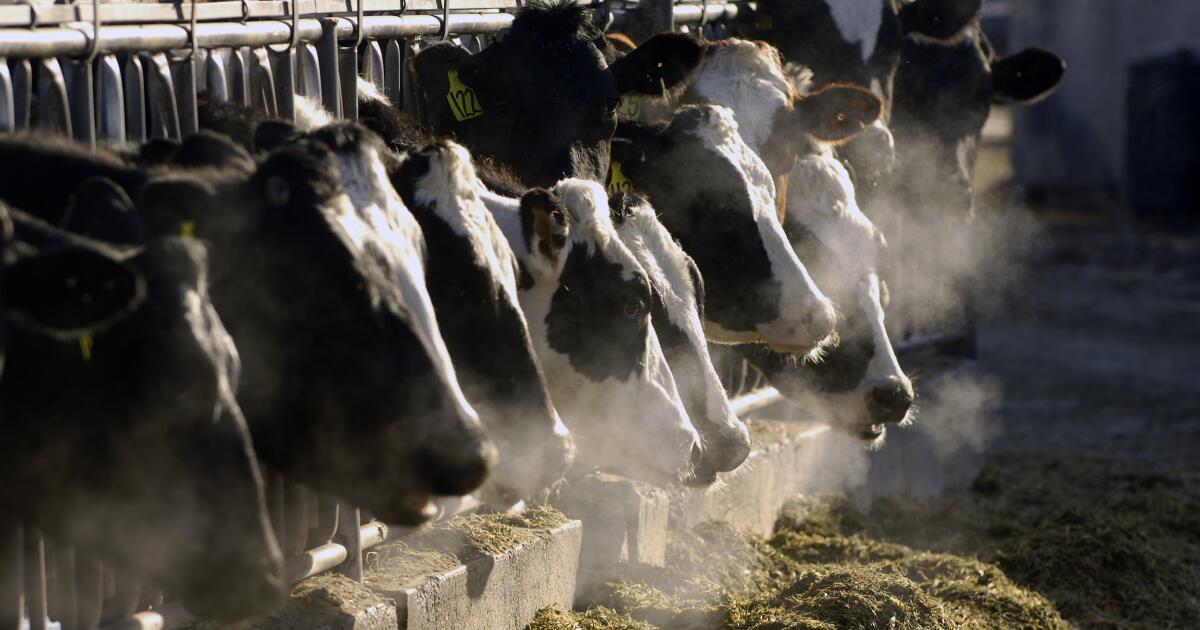Second human case of bird flu detected in Michigan dairy worker
A second human case of bird flu in a diary worker has been confirmed in Michigan, state and federal health officials announced Wednesday.
The symptoms were mild, consisting of conjunctivitis. The Texas dairy worker who contracted the virus in March also came down with pink eye.
At a press call on Wednesday, Nirav Shah, principal deputy director of the U.S. Centers for Disease Control and Prevention, said the finding was “not unexpected” and that it was a scenario “that we had been preparing for.”
He said that since the discovery of H5N1 in dairy cattle, state and federal health officials have been closely monitoring farmworkers and slaughterhouse workers and urging farmers and farmworker organizations to “be alert, not alarmed.”
Federal officials say they still believe the human health risk of bird flu is low; however, it underscores the need for people who are interacting with infected or potentially infected farm animals or birds to take precautions, including avoiding dead animals and wearing personal protective equipment (PPE) if there’s a need to be in close contact.
Though a nasal swab from the person in Michigan tested negative for influenza, an eye swab from the patient was shipped to the CDC and tested positive for influenza A(H5N1) virus.
This is the third case of H5N1 reported in the United States. A poultry worker in Colorado was identified in 2022.
Although the symptoms in the three farmworkers in the U.S. have been mild, people elsewhere in the world have suffered more severe illness, including death. According to the World Health Organization, between Jan. 1, 2003, and March 28, 2024, there have been 888 cases of human infection from 23 countries; 463 were fatal.
In preparation for a more widespread outbreak, the CDC updated its guidance for PPE in dairies and issued a nationwide order for healthcare providers to be on the lookout for novel influenza.
On Tuesday, the CDC asked clinical laboratories and health departments to increase the number of influenza samples being analyzed “to maximize the likelihood of catching a case of H5N1 in the community,” Shah said.
The US Department of Agriculture is also expanding its surveillance and support by providing $1500 to non-infected farms to beef up biosecurity, and $100 to producers who want to buy inline samplers to test their milk. The agency will also provide $2000 per farm to cover veterinary fees for testing, as well as shipping costs to send those tests to laboratories for analysis.
There have been no cases of H5N1 detected in California’s dairy herds.
Officials said ongoing analysis of the nation’s dairy supply suggests it is safe to consume, Despite the risk to human health being low, an official with the Administration for Strategic Preparedness and Response said it will make Tamiflu available upon request “to jurisdictions that do not have their own stockpile and are responding to pre-symptomatic persons with exposure to confirmed or suspected infected birds, cattle or other animal exposures.”
Dawn O’Connell, assistant secretary of the preparedness agency, said it started the “fill and finish” process for approximately 4.8 million doses of vaccine “that is well matched to the currently circulating strain of H5N1 through the national pre-pandemic influenza vaccine stockpile program.”
She said the decision to get started on H5N1 vaccines was not a response to any heightened concern, but since it takes several months to fill and finish vaccine doses, the agency “thought it made sense given what we were seeing.”

